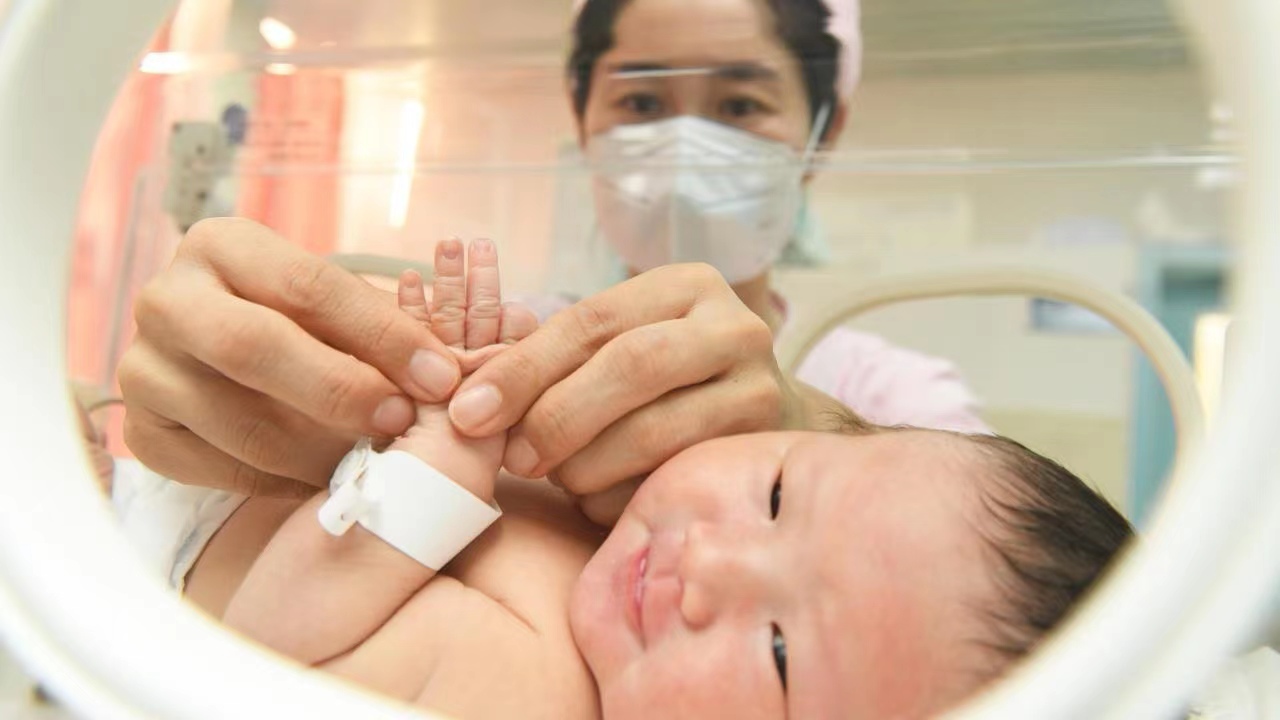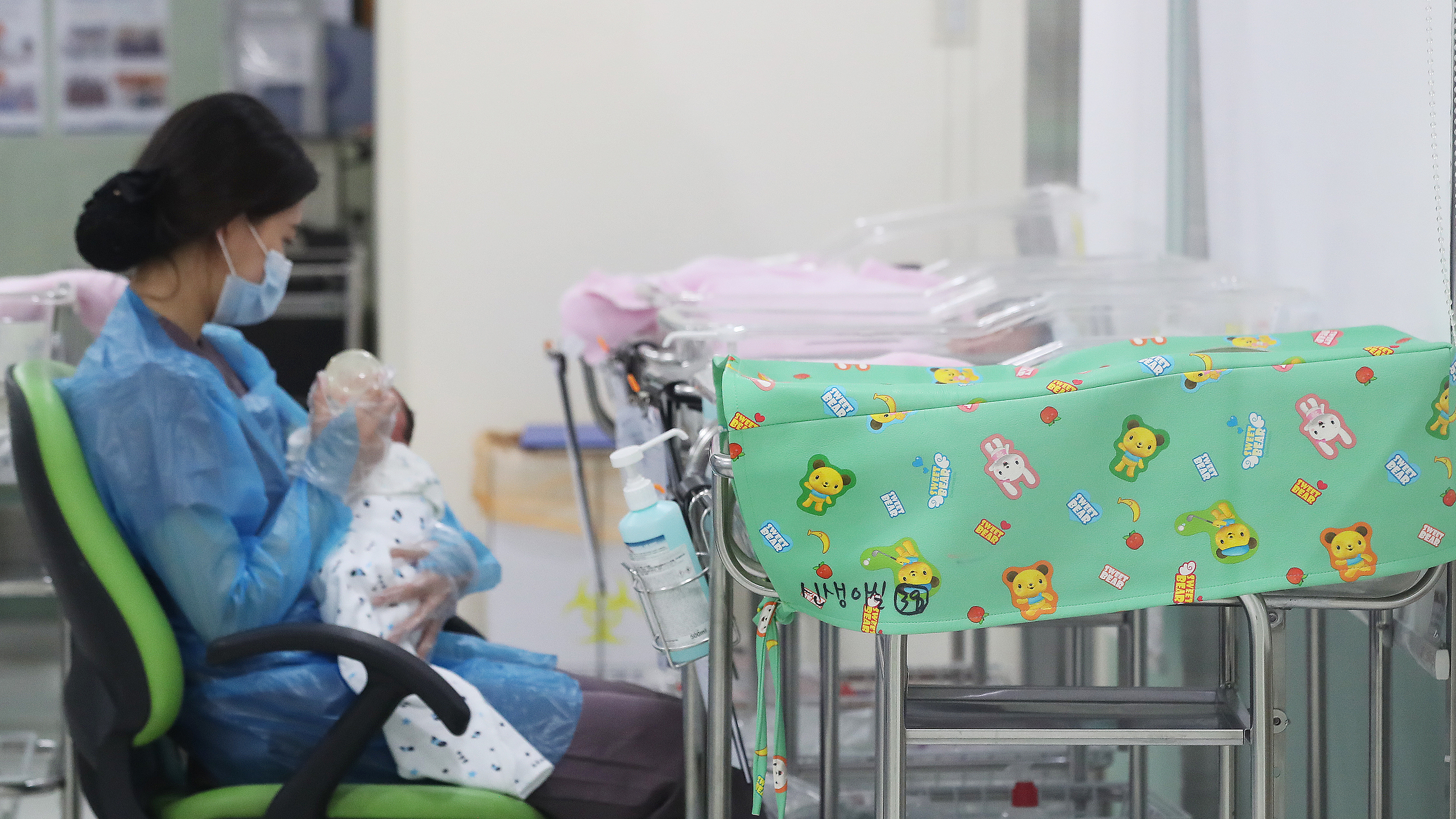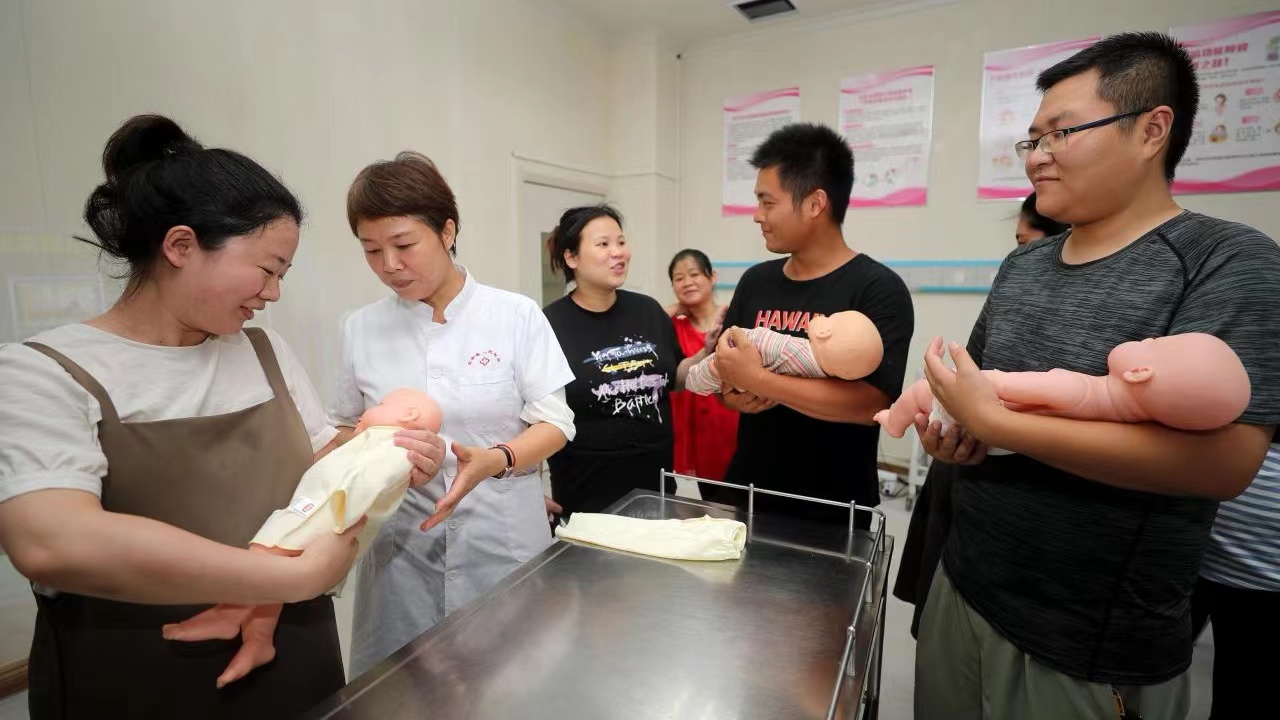
A newborn at the newborn unit of Xinle City Hospital in Shijiazhuang, capital of north China's Hebei Province, December 31, 2022. /CFP
A newborn at the newborn unit of Xinle City Hospital in Shijiazhuang, capital of north China's Hebei Province, December 31, 2022. /CFP
With some colleagues welcoming a second child, Gloria Zhao also wants a sibling for her three-year-old daughter. But several concerns have made her hesitant.
"My husband worries about not having enough money to raise another child, and I worry about not having the time," said Zhao, who lives and works in Beijing.
Zhao needs to decide quickly as she will soon pass her prime child-bearing years. Her concerns in childcare are shared by tens of millions of couples across China.
Recent population data released by China, Japan and South Korea show that negative population growth is taking hold in these East Asian countries.
Data from the National Bureau of Statistics shows China's population declined by 850,000 by the end of 2022, ushering in the stage of negative population growth.
The number of babies born in Japan in 2022 fell below 800,000, according to the Ministry of Health, Labour and Welfare, setting a record low for seven consecutive years. After reaching its peak in 2008, Japan's population has been declining for more than a decade.
The total fertility rate, the average number of children expected per woman during her lifetime, decreased to 0.78 in South Korea in 2022, according to Statistics Korea, the lowest since the statistics began in 1970. In 2021, the country first experienced population decline since 1950s.
"China's population may fluctuate a bit in the next five years, but will continue to experience negative growth in five to 10 years," said Professor Li Ting, population development studies center, Renmin University of China, who is also a member of Beijing Municipal Committee of the Chinese People's Political Consultative Conference.
Li added that populations in these three countries will continue to decline until the end of this century.
She said low fertility rate, the major reason behind population decline, is a by-product of economic and social development.
"Nearly all developed economies in the world have low fertility rate. The better a social security system develops, the less people rely on the family for elderly care," said Li.
"As for changing values, some people no longer see marriage and childbearing as must-have experiences in life," she said.

The newborn unit of a maternity hospital in Seoul, South Korea, February 27, 2019. /CFP
The newborn unit of a maternity hospital in Seoul, South Korea, February 27, 2019. /CFP
The dilemma
Professor Li's study focuses on demographic and family transitions, and she observes that East Asian countries share some similarities in causes of low fertility rate.
"In Confucian culture, parents tend to plan ahead and prepare enough resources to support the growth of offspring," she said.
"One key phenomenon is that East Asian parents attach great importance to their children's education which is seen as the key in securing a bright future. Parents have to reduce the number of children due to limited resources."
Li also noticed that women from East Asia experience conflict between their roles at home and at work.
Data from the UNESCO Institute of Statistics shows the share of female students in tertiary education has increased in China, Japan and South Korea in the past two decades, which can boost women's economic participation and job opportunities.
However, the global gender gap index rankings of South Korea (99th), China (102nd) and Japan (116th) are lagging behind in the world, according to the Global Gender Report 2022 released by the World Economic Forum.
"In East Asia, women are still the main caregivers for the elderly and children. Having children can have a negative impact on their career and income. Some women choose to give up marriage or have fewer children as a result," Li said.
Not only women, many young people in East Asia grew up in a hardworking culture and tend to delay starting a family, as they have to or need to work overtime to make career achievements and higher incomes, according to Li.
Prior to the COVID-19 pandemic, South Asia (49.0) and East Asia (48.8) have the longest average number of working hours per week in paid work, with the global average of 43.9 hours, according to a 2022 report by the International Labour Organization. The report says East Asia records the highest 51.2 working hours in a week per worker in the informal sector.
Li added that most East Asians regard marriage as a prerequisite for having children, and the proportion of childbearing outside marriage in East Asian countries is low compared with other countries.
"As young people delay or refuse marriage, the fertility rate in society as a whole falls, even if the rate within marriage remains the same," said Li.
"We need to create a supportive environment for young people, including stable job, steady increase of income and security of housing. If they have good expectations for the future, they will be willing to have more children," she said.

Young couples learn newborn care at Quanjiao County People's Hospital in Chuzhou, east China's Anhui Province, July 9, 2021. /CFP
Young couples learn newborn care at Quanjiao County People's Hospital in Chuzhou, east China's Anhui Province, July 9, 2021. /CFP
Responses in China
Responses to the population decline have become a hot topic during China's Two Sessions in recent years. Some proposals to provide supportive policies for new parents have made their way into local laws and regulations, including more paid parental leaves, childcare subsidies, tax cuts and narrower gender gap in the workplace.
In the political season this year, more proposals are put forward to reduce the cost of childbirth, childcare and education.
"The goal of these supportive policies is to enable those who want to have children to realize their dreams," said Li. "These policies are necessary and will be effective."
But Li noted that these policies need time to be perfected and implemented, and are unlikely to reverse the population decline trend in China.
"China will face similar problems that are happening in Japan and South Korea, with population aging as the biggest challenge. More resources should be tilted towards the elderly in the future," said Li.
Taking the aging situation in rural China as an example, she said it could be eased as more young people choose to seek career opportunities in rural areas, following the country's push to achieve rural revitalization.
"China's large population gives us more leeway to cope with the decline's impact on consumption and innovation," Li said.
Looking on the bright side, Li said population decline may reduce the pressure of ecological goals in China's green transition, and parents' emphasis on education has prepared the country's human capital.
"At present, our country's development path should try to adapt to the changes in its population structure, rather than the other way around," said Li.